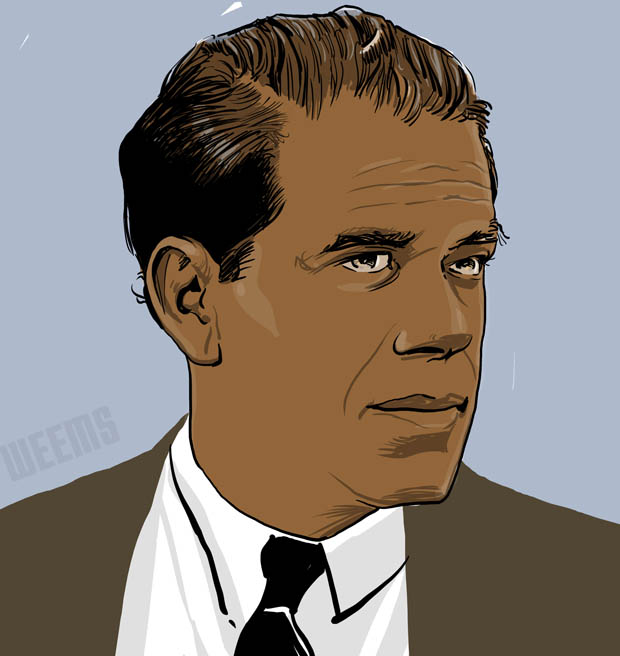Meet John Doe - 1941
"...Washington! And a guy named Jefferson - - Lincoln. Lighthouses, John! Lighthouses in a foggy world."
Meet John Doe - 1941
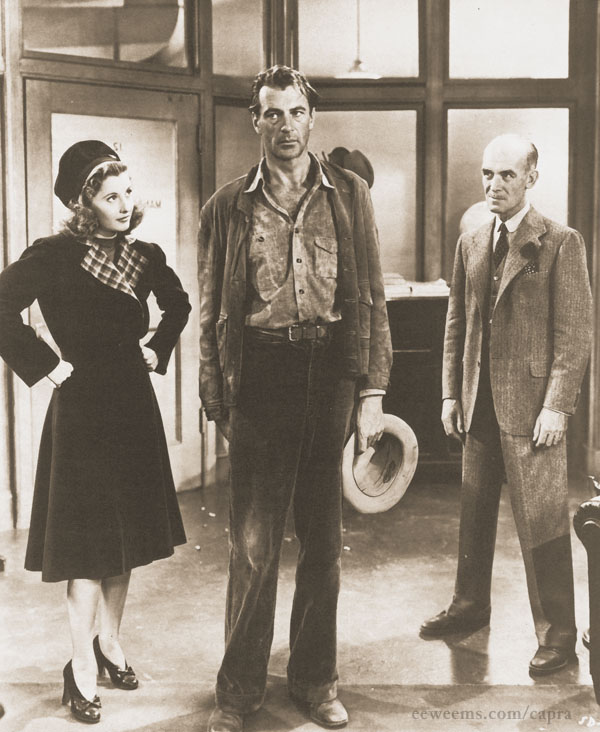
John Willoughby is an out-of-work ball player on the bum when he is hired to pretend he is "John Doe," a person invented by a female newspaper columnist declaring suicide in protest against the 'state of civilization.' Made popular thru newspaper and radio appearances, 'John Doe' finds himself the pawn of a wealthy industrialist who is manipulating him toward political ends. Willoughby, discovering the fascist goals of the political machine built around his popularity, rebels, intending to tell the truth. Instead he is exposed as a fake, and is shunted aside as a scam artist by the people who once idealized him. Distraught and in hiding, does John Willoughby, aka 'John Doe,' go thru with the suicide-protest?
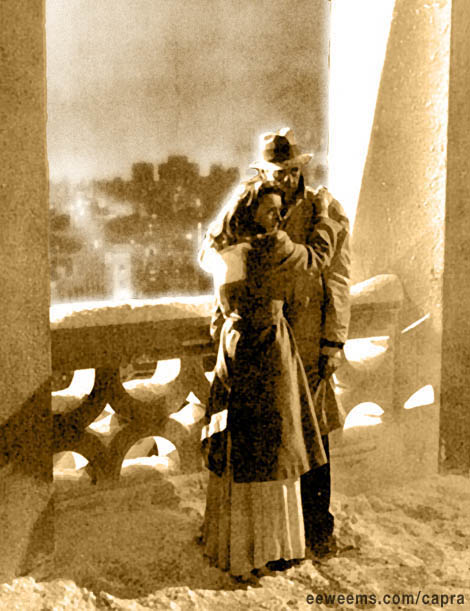
About the Film
Robert Riskin, Capra's screen-writer on Platinum Blonde, It Happened One Night, among others, had quit working for MGM, and Capra was unemployed after leaving Columbia. Together they decided to start "Frank Capra Productions" in 1939 and to then produce their own films. Riskin first proposed a film on the life of Shakespeare, and Capra countered with a film version of Cyrano de Bergerac, or Don Quixote. Finally Riskin and Capra settled on "The Life and Death of John Doe," a film treatment that had come from the story "A Reputation," first printed in 1922 in Century Magazine, and collected in the 1924 book Apes and Angels, by writer Richard Connell. The film treatment was brought to Riskin by Robert Presnell, who wrote it in conjunction with Connell.
The Life and Death of John Doe soon was shorted to The Life of John Doe, and then finally Meet John Doe when announced November 4, 1939.
"..Meet John Doe, my first completely independent film venture, was aimed at winning critical praises.
Hitler's strong-arm success against democracy was catching. Little "Führers" were springing up in America, to proclaim that freedom was weak, sterile, passé. The "new wave" was Blood Power! Destroy the weak, the Jews, the blacks; destroy Christianity and its old-hat commandment "Love thy neighbor." Arriba the Herrenvolk!
Riskin and I would astonish the critics with contemporary realities: the ugly face of hate; the power of uniformed bigots in red, white, and blue shirts; the agony of disillusionment, and the wild dark passions of the mobs. We would give them a brutal story that would make Ben Hecht sound like Edgar Guest." (Page 297)
Quoted from Capra's autobiography The Name Above The Title, New York, Macmillan, 1971
Meet John Doe was filmed on the Warner Bros Burbank, Calif, lot in the studios that had once housed Hearst's Cosmopolitan Pictures. Jack Warner put in $500,000 as part of a deal with Frank Capra Productions, and Riskin put up stocks and bonds as collateral. Capra himself mortgaged his home and his farmland.
As the coordinator to keep Capra on schedule, Robert Riskin managed to bring Capra to a close only five days over schedule during the initial production phrase (Capra ran 134 days over schedule on Lost Horizon). According Joseph McBride's book Frank Capra: The Catastrophe of Success, Capra shot 386,350 feet of film for Meet John Doe, a 34 to 1 ratio for the final film length.
A departure from the usual Riskin-Capra lead character, 'Long John Willoughby' was, as Capra said:
"...a drifter who didn't give a damn whether he was good or bad." Which was "one of the reasons we got so mixed up." (From page 431, Joseph McBride , Frank Capra: The Catastrophe of Success.
Barbara Stanwyck plays a career newspaper woman who is suddenly fired along with a host of other employees as part of an effort to modernize their newspaper "The Bulletin", and in a bitter, angry tirade she concocts a fictional account of a "John Doe" who has pledged to commit suicide off the city hall roof on Christmas Eve to protest the state of civilization.
The hoax becomes a sensation, with concerned citizens all over the unnamed city pledging to help this "John Doe," ceaselessly calling the newspaper and city officials. The newspaper editor Connell (played by James Gleason) brings Barbara Stanwyck's character back in demanding information on this mysterious figure, only to discover she made him up. He soon finds himself on the receiving end of Stanwyck's characters maneuvers, as she has a plan to reveal the whole thing as a fiction to rival newspapers. Connell's only way out is to hire her back, give her a bonus, and above all hire someone to pretend to be "John Doe" until all of the attention has died down.
Actress Barbara Stanwyck who plays newspaper woman Ann Mitchell in the film. The actress Ann Sheridan was Capra's first choice for the Ann Mitchell role, perhaps because at the time Stanwyck had such a heavy schedule: the actress also made Howard Hawk's Ball of Fire and Preston Sturges' The Lady Eve for release in 1941. Apparently Sheridan was not available from Warner Brothers.
From a crowd of hobos in the newspaper lobby all declaring they wrote the letter in the hope of securing a meal or work, Mitchell selects "Long John Willoughby" played by Gary Cooper. With the cast now assembled, Capra's film takes off, ultimately leading to "John Doe" going so far into the charade that he is almost believing he did write the original letter. Ironically, by the end of the film, "Long John Willoughby" does end up writing an authentic suicide note.
Suicide, real or attempted, figures in other Capra movies, including The Bitter Tea of General Yen, The Way of the Strong, and also It's A Wonderful life.
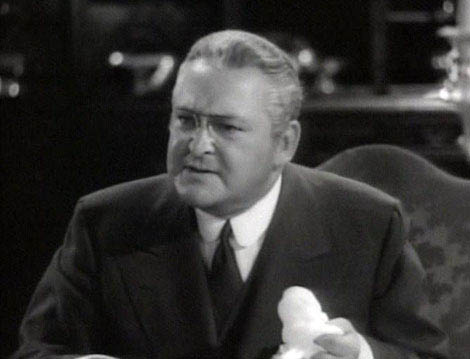
Actor Edward Arnold as D. B. Norton, the character that signs all of the checks that creates the "John Doe Movement" in the story. He plans to use the organization as an end-run around the two political parties and propel himself to the White House. As the character says in the film: "It's time for a new order of things... What the American people need is a iron hand!"
"Five Endings in search of an audience..."
That is what Capra called his efforts at reconciling the story problem within his Meet John Doe plot. Three of the unused endings were:
- John Doe jumps off the roof, and the film ends with the Colonel cradling the dead Doe in his arms. This was apparently Riskin's choice for the film (see page lviii in Six Screenplays of Robert Riskin, University of California Press, 1997)
- D. B. Norton, the would-be fascist dictator who exposed Doe as a fraud, ultimately apologizes for destroying the John Doe movement and offers to publish Doe's suicide note in his newspaper. Norton's last remark is "Merry Christmas."
- After Doe is exposed, the film ends with Gleason's newspaper editor at the police station mumbling, "Well boys, chalk up another one to the Pontius Pilates."
The delimma of the ending to Meet John Doe provoked a great deal of fan mail critiqueing Capra's film, but also congratulating him on making something out of the ordinary and with a sophisticated political sense about contemporary America and the problems it was facing in 1941. In Eric Smoodin's Regarding Frank Capra (Duke University Press, 2004) on page 154 Smoodin reprints a Capra letter to a fan who had written the director protesting that his portrayal of the mob at the rained-out convention that turns so viciously on their hero was false, because no 'John Doe' would do that. Capra replied that they indeed would, "...I say the world today is a pretty good example that they do do it."
The film was a financial and critical success, with the caveat of the problematical ending, and that contributed to the demise of Capra's independent venture, as the taxes on his earnings for the film ran to 90% in the hyper-leveraged days of the early 1940s, making it almost pointless to try and succeed on his own. He instead was soon looking for a contract directorship, which brought him to filming Arsenic and Old Lace with Cary Grant (the film would not be released until 1944).
"...Our story problem was self-inflicted. To convince important critics that not every Capra film was written by Pollyanna, and that I could handle hard-nosed brutality with the best of the groin-kickers, Riskin and I had written ourselves into a corner. We knew we were loaded with entertainment; we had a startling opening and a powerful development that rose inexorably to a spectacular climatic wow. But – we had no acceptable SOLUTION to our story. (Page 303)
...Meet John Doe's inside joke was on the bizarre side – "The Mystery of the Unsolved Ending," we called it. It is astonishing, but true; Meet John Doe missed being a lasting film classic because we couldn't end it!
...In desperation – setting some kind of pointless record – I was to photograph five different endings, and then try them out on theater audiences; all collapsed like punctured balloons. Why? Why did the hundred of scenes integrate into a jigsaw puzzle that had greatness written all over it except for one gaping hole no last scene would plug up? I never found out why." (Page 304)
Quoted from Capra's autobiography The Name Above The Title, New York, Macmillan, 1971
Frank Capra Productions sold the rights to Meet John Doe to Goodwill Pictures in 1945. The copyright passed into public domain when it's renewal date was missed in 1969 (hence the cheap "knock-off" editions that are often found on videotape and DVD). In the 1970s several prints were combined to make the best possible preservation print, and donated to the Library of Congress. Generally, most prints that are in circulation are in very poor condition.
"In his autobiography Capra, hardly a man to run himself down, admits that he embarked on the film without knowing how he was going to get himself and his hero out of it. A minor-league ballplayer (Gary Cooper). permanently benched by a bum elbow, agrees to represent himself as John Doe, fictitious author of a fictitious letter, in which Doe promises to commit suicide on Christmas Eve in protest against 'the state of civilization." John Doe becomes the enflamed spokesman for 'the little punks,' against the callous powers-that-be, and a populist movement springs up across the country. Everybody's feeling pretty good until "Doe" discovers that the homegrown fascist who's been backing the campaign (redoubtable Capra plutocrat Edward Arnold) intends to use the movement to put himself into the White House. How John Doe and the movement hit th fan makes for the most powerful, sociopolitical frenzy in Capra's frequently frenzied oeuvre, and in the wake of it all, it looks as if John will have to take that promised dive off City Hall roof after all, as the only honorable vindication of a tainted but beautiful idea."
"Time has been good to Meet John Doe. Its very unresolved quality has a potent rightness about it today (perhaps we can flatter ourselves that we are less demanding of neat tying-up of loose ends than were the reviewers of 1941); more than ever, it seems an honest and courageous film for Capra to have made. Like most screen stars, Cooper is most appealing when a filmmaker dares to peek behind the official her mask and sardonically demonstrate how all the charisma and trademark gestures can be cannily exploited to dupe a myth-hungry populace. Barbara Stanwyck is wonderfully gutsy as the hard-boiled newspaper dame who dreams up the John Doe idea as a circulation-builder, then gets to believe in it. (Front-row-center Freudians can have a field day over the romance that develops between her character and the fictitious John Doe - only one ripe example of the blackness that often peeked through the supposedly simple-minded sentimentality of Frank Capra movies.)"
(Richard T. Jameson, Kit Parker Film Catalog, 1978-1979, page 40)
Ann Mitchell is begging Willoughby not to jump; she declares that they can both start over "clean" – both characters had sold themselves to D. B. Norton, but both quit when they realized the extent of Norton's fascist ambition. But will John jump? That was the nut Capra and Riskin couldn't crack
SCREENPLAY EXCERPT
Close shot: JOHN and CONNELL. CONNEL looks around guardedly, to make certain he is not overheard.
CONNEL
(confidentially) Yessir. I'm a sucker for this country.
(gets a little sore about it)
I'm a sucker for the Star Spangled Banner - - and I'm a sucker for this country.
(taps table with middle finger)
I like what we got here! I like it!
(emphasizes each point)
A guy can say what he wants - - and do what he wants - - without having a bayonet shoved through his belly.
Med. shot : As he leans back and nods his head, satisfied he made his point.
CONNEL Now, that's all right, isn't it?
JOHN You betcha.
Title screen to Meet John Doe. Notice that in Riskin's screenplay, he named one of the main characters after one of the original writers of the story.
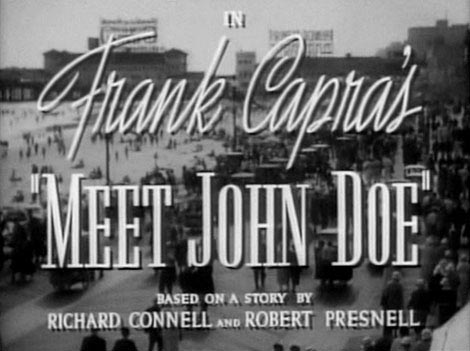
The film story begins with an anonymous workman removing the old sign from the newspaper where Ann Mitchell is being fired, along with all of the other "deadwood" by D. B. Norton's new editor and chief, Henry Connell (played by James Gleason).
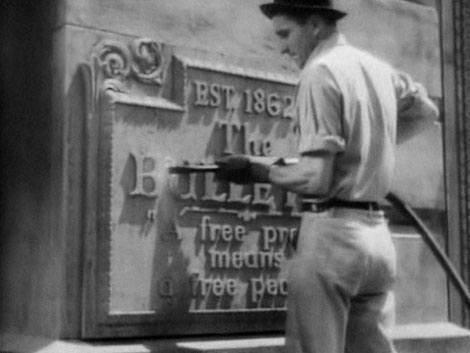
In particular, Capra and Riskin want the audience to notice what is being chiseled off the sign.
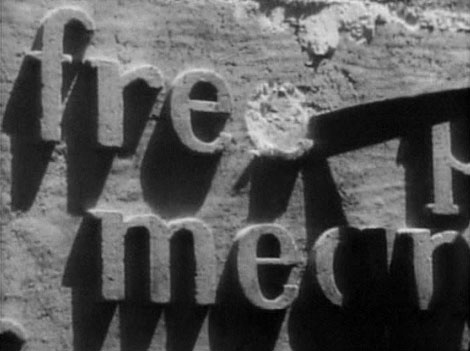
Barbara Stanwyck's character Ann Mitchell is contemplating her dismissal. The whole film hinges upon this character who (depending upon your point of view) corrupts "Long John Willoughby" from an easy-going guy who previously cared nothing for people or politics, or she is the instrument to wake him up from his self-obsessed daydreams.
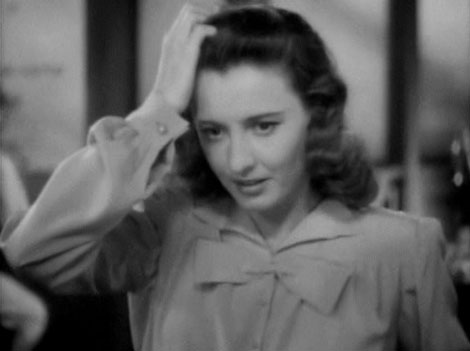
Ann Mitchell goes back into Connell's office after being fired. She is going to beg for her job, only to be refused. Notice what Capra has us see stenciled on the wall as a shadow from the "Bulletin's" outdoor sign.
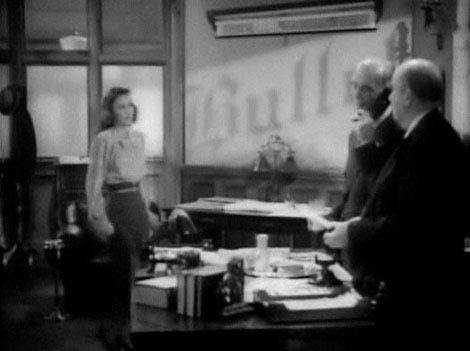
MEET
JOHN DOE
1941
During production, the project was variously titled:
The Life and Death of John Doe
The Life of John Doe
Released on May 3, 1941
Premiered in Hollywood and New York City on March 12, 1941
Four versions are known to be listed in various periodicals: 123, 125, 129 and 135 minutes. However, according to IMDB, there has only been one "official" length and that is 123 minutes.
Black and White
Sound by RCA Sound System (mono track)
Production Dates:
July 8, 1940 - Sept 18, 1940;
Nov 14 - 18, 1940 ;
January 3 - 24, 1941;
March 23, 1941 at Warner Bros.
Final Length:
11, 109 feet of film; 14 Reels
Film produced by Frank Capra Productions, Inc.
Distributed by Warner Bros. Pictures, Inc.
Copyright was sold in 1945 to Goodwill Pictures; the copyright renewal date was missed and the film passed into public domain.
Produced and Directed by Frank Capra. Script by Robert Riskin (and Myles Connolly, uncredited). From the screen treatment "The Life and Death of John Doe" by Richard Connell and Robert Presnell, based on Connell's story "A Reputation." Cinematographer: George Barnes.
CASTGary Cooper |
"Long John" Willoughby |
Links
Page about Barbara Stanwcyk at Cinemagraphe
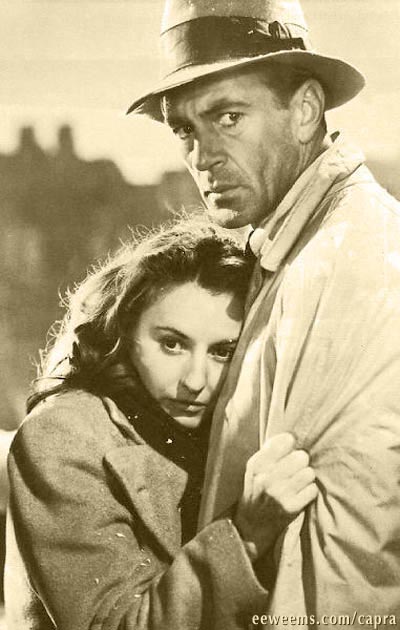
More info coming
Original page 2002 | Updated April 2013
